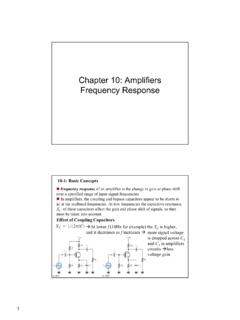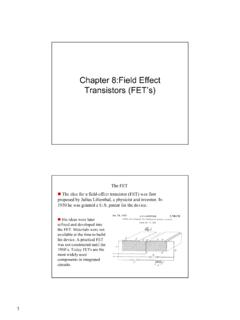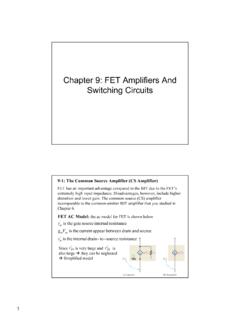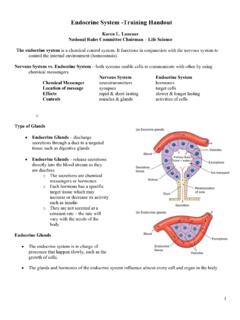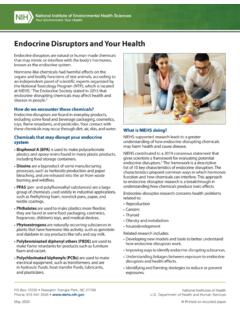Transcription of Physiology and Anatomy of the Endocrine System
1 Physiology and Anatomy of the Endocrine System Prepared by Dr. Naim Kittana, PhD. An-Najah National University Faculty of Medicine and Health Sciences Department of Biomedical Sciences Introduction The nervous and Endocrine systems are the major controlling systems of the body. The nervous System exerts rapid controls via nerve impulses;. the Endocrine System exerts more prolonged effects via hormones. Dr. Naim Kittana, PhD 2. The Endocrine System : An Overview Hormonally regulated processes include: Reproduction Growth and development Maintaining electrolyte, water, and nutrient balance Regulating cellular metabolism and energy balance Mobilizing body defenses. Dr. Naim Kittana, PhD 3. Endocrine organs They are ductless, well- vascularized glands that release hormones directly into the blood or lymph. Dr. Naim Kittana, PhD 4. The Endocrine organs include Pituitary Thyroid Parathyroid Adrenal Pineal glands The hypothalamus (a neuroendocrine organ).
2 The pancreas Gonads Placenta Dr. Naim Kittana, PhD 5. Notes Local chemical messengers, not generally considered part of the Endocrine System , include autocrines, which act on the cells that secrete them, and paracrines, which act on a different cell type nearby. Most hormones are steroids or amino acid based Dr. Naim Kittana, PhD 6. Mechanisms of Hormone Action Hormones alter cell activity by stimulating or inhibiting characteristic cellular processes of their target cells. Cell responses to hormone stimulation may involve: Changes in membrane permeability Enzyme synthesis, activation, or inhibition Secretory activity Mitosis Dr. Naim Kittana, PhD 7. Plasma Membrane Receptors and Second-Messenger Systems Dr. Naim Kittana, PhD 8. Intracellular Receptors Steroid hormones (and thyroid hormone) enter their target cells and effect responses by activating DNA, which initiates messenger RNA formation leading to protein synthesis.
3 9. Target Cell Specificity The ability of a target cell to respond to a hormone depends on the presence of receptors, on its plasma membrane or within the cell, to which the hormone can bind. Hormone receptors are dynamic structures. High or low levels of stimulating hormones can change the number and/or sensitivity of hormone receptors. Dr. Naim Kittana, PhD 10. Control of Hormone Release Humoral, neural, or hormonal stimuli activate Endocrine organs to release their hormones. Negative feedback is important in regulating hormone levels in the blood. The nervous System , acting through hypothalamic controls, can in certain cases override or modulate hormonal effects Dr. Naim Kittana, PhD 11. Types of Endocrine gland stimuli 12. Half-Life, Onset, and Duration of Hormone Activity Blood levels of hormones reflect a balance between secretion and degradation/excretion. The liver and kidneys are the major organs that degrade hormones.
4 Breakdown products are excreted in urine and feces. Hormone half-life and duration of activity are limited and vary from hormone to hormone. Dr. Naim Kittana, PhD 13. The Pituitary Gland and Hypothalamus Dr. Naim Kittana, PhD 14. Pituitary-Hypothalamic Relationships The pituitary gland hangs from the base of the brain and is enclosed by bone. It consists of a hormone-producing glandular portion (anterior pituitary or adenohypophysis) and a neural portion (posterior pituitary or neurohypophysis), which is an extension of the hypothalamus. The neurohypophysis includes the infundibulum (stalk) and the posterior pituitary. Dr. Naim Kittana, PhD 15. 16. The hypothalamus (a) synthesizes two hormones that it exports to the posterior pituitary for storage and later release and (b) regulates the hormonal output of the anterior pituitary via releasing and inhibiting hormones. Dr. Naim Kittana, PhD 17. The Posterior Pituitary and Hypothalamic Hormones The posterior pituitary stores and releases two hypothalamic hormones: Oxytocin Antidiuretic hormone (ADH).
5 Dr. Naim Kittana, PhD 18. Oxytocin It stimulates powerful uterine contractions, which trigger labor and delivery of an infant It stimulates milk ejection in nursing women. Its release is mediated reflexively by the hypothalamus and represents a positive feedback mechanism. Dr. Naim Kittana, PhD 19. Antidiuretic hormone (ADH). It stimulates the kidney tubules to reabsorb and conserve water, resulting in small volumes of highly concentrated urine and decreased plasma solute concentration. ADH is released in response to high solute concentrations in the blood and inhibited by low solute concentrations in the blood. Hyposecretion results in diabetes insipidus Dr. Naim Kittana, PhD 20. Anterior Pituitary Hormones Four of the six anterior pituitary hormones are tropic hormones that regulate the function of other Endocrine organs. Most anterior pituitary hormones exhibit a diurnal rhythm of release, which is subject to modification by stimuli influencing the hypothalamus.
6 Dr. Naim Kittana, PhD 21. Anterior Pituitary Hormones 22. Anterior Pituitary Hormones Growth hormone (GH). Thyroid-stimulating hormone (TSH). Adrenocorticotropic hormone (ACTH). The gonadotropins follicle-stimulating hormone (FSH) and luteinizing hormone (LH). Prolactin (PRL). Dr. Naim Kittana, PhD 23. Growth hormone (GH) (somatotropin). It is an anabolic hormone that stimulates growth of all body tissues but especially skeletal muscle and bone. It may act directly, or indirectly, via insulin-like growth factors (IGFs). GH mobilizes fats, stimulates protein synthesis, and inhibits glucose uptake and metabolism. Its secretion is regulated by growth hormone releasing hormone (GHRH) and growth hormone inhibiting hormone (GHIH), or somatostatin. Dr. Naim Kittana, PhD 24. Growth-promoting and metabolic actions of GH. 25. Dr. Naim Kittana, PhD. Growth hormone (GH). Hypersecretion causes gigantism in children and acromegaly in adults Hyposecretion in children causes pituitary dwarfism.
7 26. Dr. Naim Kittana, PhD. Thyroid-stimulating hormone (TSH). TSH promotes normal development and activity of the thyroid gland. Thyrotropin releasing hormone (TRH) stimulates release of TSH. Negative feedback of thyroid hormone inhibits it. GHIH also inhibits TSH. secretion Dr. Naim Kittana, PhD 27. Anterior Pituitary Hormones 28. Adrenocorticotropic hormone (ACTH). It stimulates the adrenal cortex to release corticosteroids. Corticotropin-releasing hormone (CRH) triggers ACTH release Rising glucocorticoid levels inhibit it. Dr. Naim Kittana, PhD 29. Anterior Pituitary Hormones 30. FSH and LH. The gonadotropins FSH and LH regulate the functions of the gonads in both sexes. In both sexes, FSH stimulates production of gametes (sperm or eggs), while LH stimulates gonadal hormone production. Dr. Naim Kittana, PhD 31. FSH and LH. In females, LH works with FSH to cause an egg-containing ovarian follicle to mature.
8 LH then triggers ovulation and promotes synthesis and release of ovarian hormones. In males, LH stimulates the interstitial cells of the testes to produce the male hormone testosterone. Gonadotropin levels rise in response to gonadotropin- releasing hormone (GnRH). Negative feedback of gonadal hormones inhibits gonadotropin release. Dr. Naim Kittana, PhD 32. Dr. Naim Kittana, PhD 33. FSH and LH. Gonadotropins are virtually absent from the blood of prepubertal boys and girls. During puberty, the gonadotropic cells of the anterior pituitary are activated and gonadotropin levels rise, causing the gonads to mature. In both sexes, gonadotropin releasing hormone (GnRH). produced by the hypothalamus prompts gonadotropin release. Gonadal hormones, produced in response to the gonadotropins, feed back to suppress FSH and LH release. 34. Prolactin (PRL). It promotes milk production in humans. Its secretion is inhibited by dopamine, that acts as a prolactin- inhibiting hormone (PIH).
9 Hypersecretion of prolactin (hyperprolactinemia) causes: Females: inappropriate lactation, lack of menses and infertility Males: Impotence Dr. Naim Kittana, PhD 35. The Thyroid Gland 36. The Thyroid Gland Dr. Naim Kittana, PhD 37. The Thyroid Gland The thyroid gland is located in the anterior neck. Thyroid follicles store colloid containing thyroglobulin, a glycoprotein from which thyroid hormone is derived. Thyroid hormone (TH) includes thyroxine (T4) and triiodothyronine (T3), which increase the rate of cellular metabolism. Consequently, oxygen use and heat production rise. 38. Steps of thyroid hormone synthesis: 1. Iodide is uptaken in response to TSH hormone 2. Iodide is oxidized by thyroidal peroxidase to iodine 3. Tyrosine on thyroglobulin is iodinated and forms MIT & DIT. 4. Iodotyrosines condensation MIT+DIT T3; DIT+DIT T4. Dr. Naim Kittana, PhD 39. The Thyroid Gland Secretion of thyroid hormone, prompted by TSH, requires the follicular cells to take up the stored colloid and split the hormones from the colloid for release.
10 Rising levels of thyroid hormone feed back to inhibit the anterior pituitary and hypothalamus. Most T4 is converted to T3 (the more active form) in the target tissues. These hormones act by turning on gene transcription and protein synthesis. Dr. Naim Kittana, PhD 40. Mechanism of actions of thyroid hormones Dr. Naim Kittana, PhD 41. BMR: basal metabolic rate Homeostatic Imbalance of the Thyroid Gland Hypothyroid disorders may result from: Thyroid gland defects Secondarily from inadequate TSH or TRH release. When the thyroid gland is removed surgically When dietary iodine is inadequate Hypothyroidism conditions: Myxedema, Goiter, Cretinism Hyperthyroidism condition: Graves' disease Dr. Naim Kittana, PhD 42. Myxedema Full-blown hypothyroid syndrome In adults. Symptoms include: Low metabolic rate Feeling chilled Constipation Thick dry skin Puffy eyes Edema Lethargy Mental sluggishness (but not mental retardation).




